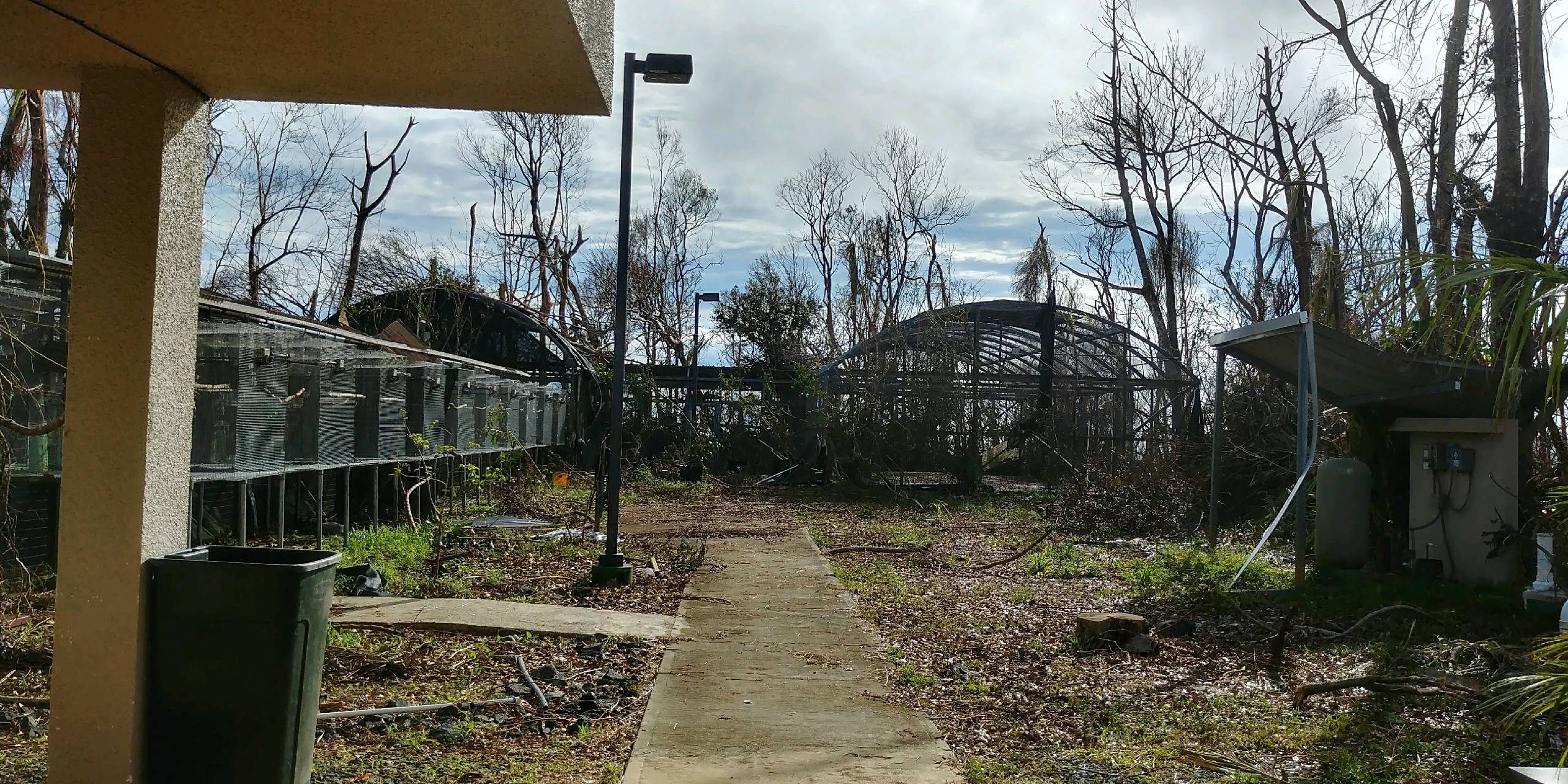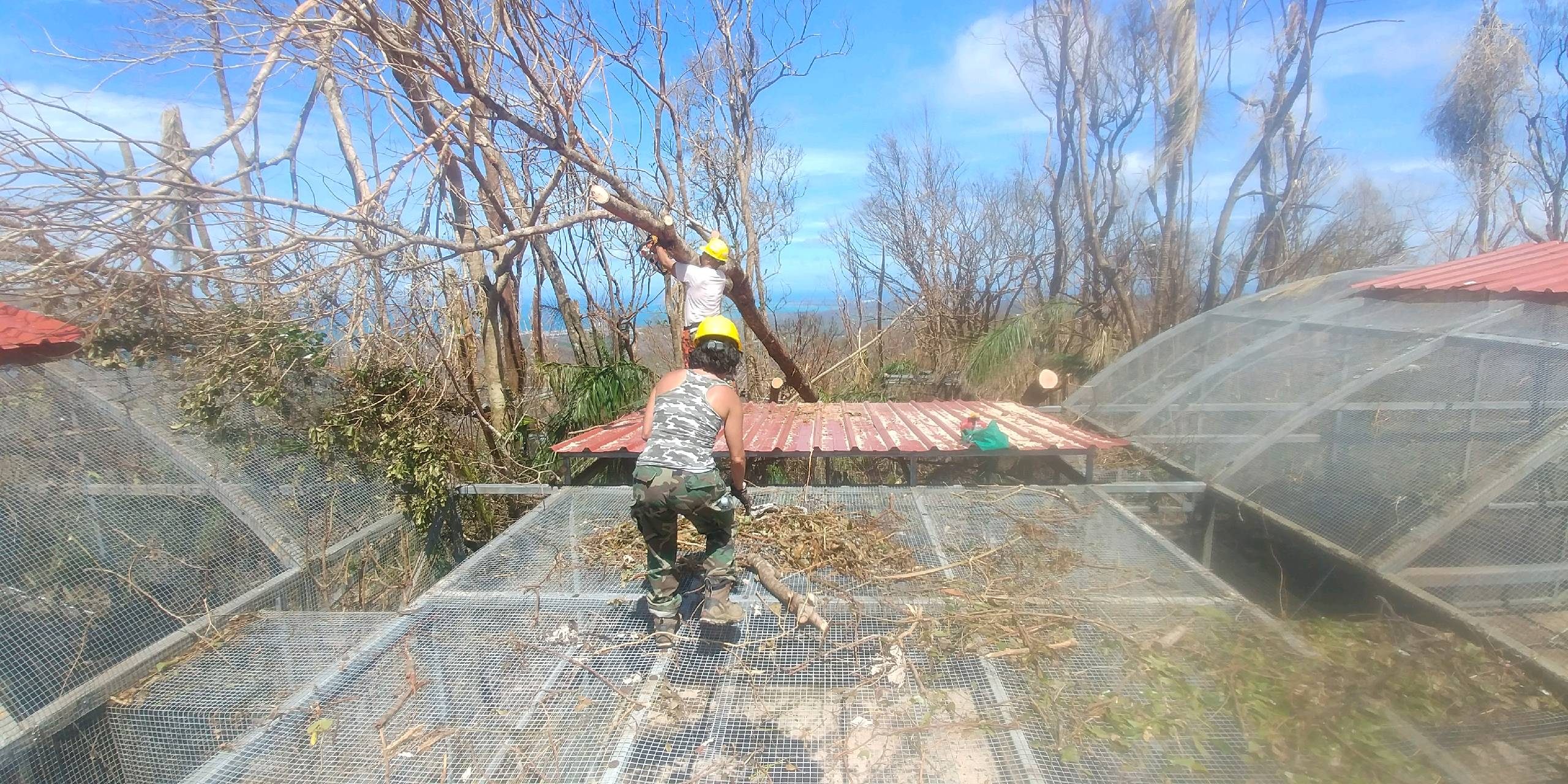Among Puerto Rico’s Displaced Residents, an Entire Flock of Endangered Parrots
Still, the island’s animal conservationists have no intention of giving up.

When parrot biologist Tom White left the safe room of the Iguaca Aviary after Hurricane Maria, the first thing he noticed was the new view. Previously, looking into Puerto Rico’s El Yunque National Forest had been a dizzying experience, all glossy leaves and shades of green. Now, he says, it looked like the New England woods in February. “It was completely denuded,” he says. “We could see five or six miles, way down to the coast.”
The second thing he noticed was the quiet. “It was just silent,” he says. “No birds were singing, nothing. All you could hear was the wind.”
This lack of shrieks was especially dispiriting. For the past 18 years, White has been working on the Puerto Rican Parrot Recovery Program, a U.S. Fish and Wildlife Department initiative focused on keeping the island’s only endemic parrot* from extinction. It’s a tough job at the best of times, but after Irma and Maria, White and his coworkers have a new set of challenges: battered equipment, a wrecked forest, and an entire flock of missing birds.

The Puerto Rican parrot looks like something out of a coloring book. Also known as the iguaca—a name given to it by the Taíno people and meant to imitate the raucous call it makes while flying—it’s bright green, with a white ring around its eyes and a scarlet spot above its curved beak. It’s about a foot long from head to tail, with blue-tipped wings for zipping in and out of the canopy, and big sharp claws to grip branches while it dines on flowers, bark, nectar, and fruits.
For much of Puerto Rico’s history, this parrot was abundant. The Taíno hunted and ate it, and legend holds that hundreds of iguacas greeted Christopher Columbus when he arrived on the island in 1493. By the founding of the first Spanish colony in the early 16th century, the bird’s overall population was estimated at a million.
Over the intervening centuries, though, deforestation and human development drove the population down. By the 1940s, there were only a few dozen Puerto Rican parrots left, all living in one spot in El Yunque. By 1973, that number had dropped to 13, and the Fish and Wildlife Department set up the parrot recovery program. They opened an aviary in the forest, and set about the difficult business of bringing the birds’ numbers back up.

After years of careful matchmaking, incubation, and tracking, things had started looking pretty good. There have been setbacks: “In 1989, we had Hurricane Hugo, which wiped out half the population,” says Marisel López, the program’s current supervisor. But recovery was swift, and the numbers soon climbed again. In 1993, the program established another facility, the José L. Vivaldi Memorial Aviary, in Rio Abajo Forest in the center of the island. In 2007, they built a new main campus in El Yunque, called the Iguaca Aviary, and in 2015, they set up a third, in Maricao Commonwealth Forest. Between captive and wild populations, the island was now home to over 500 Puerto Rican parrots.
Then came Irma and Maria’s one-two punch. White spent both storms in the aviary’s concrete hurricane room with his wife—Arely Jhonson-Camacho, who also works for the project—and about 200 captive birds. “Every time there’s a big tropical storm or hurricane, there are two employees who are assigned to stay with the parrots, just in case no one can get there for a day or two,” he explains. This time, it took six days for the rescue crews to arrive after Irma, and a full week after Maria.
Most of the captive parrots were fine, if freaked out. (During the storms themselves, “they were very quiet, and stopped moving around,” says White.) The wild ones, though, are a different story.

In the last population survey before the hurricanes, López says, she and the other scientists had counted between 53 and 56 wild parrots in El Yunque. After Irma, they did another count, and found 31. Post-Maria, it took the scientists two weeks just to reach the site where the parrots used to live, and by the time they got there, the flock was gone. “We can’t exactly tell the population size at this point,” says López, “[because] we are still trying to find it.” Locating the wild flock is López’s most urgent concern, and her team has been surveying the forest three times a week.
In the meantime, a few leads have emerged. The day after Maria, a group of four wild parrots visited the Iguaca Aviary in El Yunque, showing that they, at least, had survived the storm. The public has been helping out, drawing the aviary’s attention to potential sightings on Facebook, including one that turned out to be a recently released parrot, born in 2016.
That bird was found miles from the forest, suggesting that some of the flock may be seeking refuge elsewhere. “Maybe they’ve moved, or been displaced,” says López. Many of the parrots of Rio Abajo also made it—researchers here have counted at least 80, now subsisting mostly on royal palm fruits, as other vegetation is scarce.
Rio Abajo is heavily defoliated. Only the fruit of the royal palm has survived. The parrots are making good use of this limited resource. pic.twitter.com/9IjTFhROkl
— Tanya Martínez (@iguacachick) October 4, 2017
In worse news, a few individual birds—which were also released earlier this year, and were wearing transmitters—have been tracked down and found dead. The parrots nest in cavities in trees, and López thinks they were killed during the first bursts of heavy winds, which came around 2 a.m. “They were already asleep,” she says, “and the trees fell down.”
As they work to find the missing birds, the researchers are also focusing on other, more infrastructural priorities. Like the island as a whole, both aviaries are having trouble getting electricity and clean water. But they also have a number of iguaca-specific needs to address. Both captive breeding programs require a lot of equipment: special cages for parrot procreation; incubators to save damaged eggs and house abandoned chicks; woodchip sterilizers to make sure nests are disease-free. Inside the forests, they’ve installed networks of artificial tree cavities, designed to encourage reproduction among wild birds. El Yunque’s are accompanied by infrared cameras, to keep an eye on any youngsters that result.
High winds and downed trees wreaked havoc on these setups, especially the cages and artificial nests. Unless they are in working order by the time breeding starts in January, the species could lose a whole generation before it has even begun. López and her team are looking at weeks more of rewiring cages and clearing out debris with chainsaws. FEMA has been helping out, too. “We have to try and make all the improvements that we can, so that we can at least have a breeding season this year,” she says.

After that, it’s a waiting game. The forests where the parrots live need to heal, too. In El Yunque, what was once lush and leafy is now stick-brown, so parrots stick out like chartreuse beacons. Until the leaves and plants begin to grow back, those birds that did make it through will be living in the parrot equivalent of a house without a roof. Wild parrots have to worry about red-tailed hawks, which circle overhead and pick them off. Without the canopy, “they can’t hide,” says López.
Rio Abajo, which is at a slightly lower altitude, was spared some of the highest winds, but lost a lot of greenery as well. The biologist Tanya Martinez has been tweeting photographs of the site, which, she said, “can barely be called a forest anymore.” Researchers have been putting fallen palm fronds on top of the cages, so that the parrots inside don’t get scorched by the sun.
Experts believe that Puerto Rico’s rainforests will heal, and may even come back stronger. “It’s already starting to green up,” says White. And the members of the Puerto Rican Parrot Recovery Program are confident that, whether or not the El Yunque population returns, this isn’t the end for the bird. “We spent decades, literally, working to build the population up to where it is,” says White. “To see it get knocked back to such a low level in a day—of course it’s frustrating.”
“But if you give up,” he continues, “the hurricane wins. And we’re not going to let that happen.”
*Correction: This post previously called Puerto Rican Parrot the island’s only endemic bird species. It is not.


















Follow us on Twitter to get the latest on the world's hidden wonders.
Like us on Facebook to get the latest on the world's hidden wonders.
Follow us on Twitter Like us on Facebook